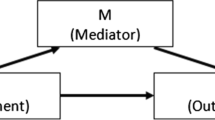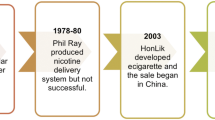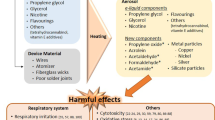Abstract
Background
Of 1 346 700 total deaths each year in the US, an estimated 440 100 are smoking related, making it the leading preventable cause of premature death in the US. Despite the health and economic benefits of smoking cessation being well documented, reimbursement coverage for smoking cessation therapies is generally limited in the US and elsewhere.
Objectives
To evaluate the cost effectiveness of varenicline, an α4ß2 nicotinic acetylcholine receptor partial agonist, recently approved to aid smoking cessation.
Methods
A Markov model, the Benefits of Smoking Cessation on Outcomes (BENESCO) model, was developed to simulate the lifetime direct costs and consequences of a hypothetical cohort of US adult smokers who make a one-time attempt to quit smoking. The smoking cessation strategies compared were varenicline, bupropion, nicotine replacement therapy and unaided quitting. The model used the hazard ratios from the Cancer Prevention Study (CPS)-II study for the mortality of smoking-related diseases as a proxy to calculate the relative risks of the incidence and prevalence of these diseases, following previously developed methodology. The costs (year 2005 values) and utilities for the included smoking-related diseases (lung cancer, chronic obstructive lung disease [COPD], coronary heart disease [CHD], stroke and asthma exacerbations), and the efficacies of the smoking cessation strategies, were sourced from the published literature. Costs and benefits were discounted at 3% pa. Probabilistic and univariate sensitivity analyses were conducted.
Results
Varenicline was found to dominate all other smoking cessation strategies that were investigated for both the 20-year and lifetime timeframe. Furthermore, if 25% of the current population of US smokers made a one-time attempt to quit using varenicline compared with unaided cessation, almost 144 000 smoking-related deaths and over 261 000 cases of asthma exacerbations, COPD, CHD, stroke and lung cancer could be avoided compared with an unaided smoking cessation strategy.
Conclusions
Varenicline, a recently approved therapy for smoking cessation, is likely to be a cost-effective alternative compared with currently available options.











Similar content being viewed by others
References
Ezzati M, Lopez AD. Regional, disease specific patterns of smoking-attributable mortality in 2000. Tob Control 2004; 13: 388–395
Centers for Disease Control and Prevention. Tobacco use among adults: US, 2005. MMWR 2006; 55 (42): 1145–1148
US Department of Health and Human Services. The health consequences of smoking: a report of the surgeon general. Atlanta (GA): US Department of Health and Human Services, Centers for Disease Control and Prevention, National Center for Chronic Disease Prevention and Health Promotion, Office on Smoking and Health, 2004
Action on Smoking and Health UK. Factsheet no. 2: August 2005 [online]. Available from URL: http://www.ash.org.uk/files/documents/ASH_107.pdf [Accessed 2006 Apr 3]
Kaper J, Wagena EJ, Severens JL, et al. Healthcare financing systems for increasing the use of tobacco dependence treatment. Cochrane Database Sys Rev 2005; (1): CD004305
Levy DT. A simulation model of policies directed at treating tobacco use and dependence. Med Decis Making 2002; 22 (1): 6–17
Foulds J, Burke M, Steinberg M, et al. Advances in pharmacotherapy for tobacco dependence. Expert Opin Emerg Drugs 2004; 9 (1): 39–53
Ranney L, Melvin C, Lux L, et al. Smoking cessation intervention strategies for adults and adults in special populations [systematic review]. Ann Intern Med 2006; Dec 5; 145 (11): 845–856
Hughes JR, Stead LF, Lancaster T. Antidepressants for smoking cessation. Cochrane Database Syst Rev 2007 Jan 24; (1): CD000031
Silagy C, Lancaster T, Stead L, et al. Nicotine replacement therapy for smoking cessation. Cochrane Database Syst Rev 2004; (3): CD000146
Woolacott NF, Jones L, Forbes CA, et al. The clinical effectiveness and cost effectiveness of bupropion and nicotine replacement therapy for smoking cessation: a systematic review and economic evaluation. Health Technol Assess 2002; 6: 16
Eddy DM. Eddy ranks the tests. Harvard Health Lett 1992; July Suppl.: 10–11
Gonzales D, Rennard SI, Nides M, et al. Varenicline, an alpha4beta2 nicotinic acetylcholine receptor partial agonist, vs sustained-release bupropion and placebo for smoking cessation: a randomised controlled trial. JAMA 2006; 296: 47–55
Jorenby DE, Taylor Hays J, Rigotti NA, et al. Efficacy of varenicline, an alpha4beta2 nicotinic acetylcholine receptor partial agonist, vs placebo or sustained-release bupropion for smoking cessation. JAMA 2006; 296: 56–63
Orme ME, Hogue SL, Kennedy LM, et al. Development of the health and economic consequences of smoking interactive model. Tob Control 2001 Mar; 10 (1): 55–61
Feenstra TL, Hamberg-van Reenen HH, Hoogenveen RT, et al. Cost effectiveness of face-to-face smoking cessation interventions: a dynamic modeling study. Value Health 2005 May–Jun; 8 (3): 178–190
Population Division, US Census Bureau. Table 1: annual estimates of the population by sex and five-year age groups for the United States: April 1, 2000 to July 1 [online]. Available from URL: http://www.census.gov/popest/national/asrh/NC-EST2004/NC-EST2004-01.xls [Accessed 2008 Mar 31]
National Center for Health Statistics. National Health Interview Survey (NHIS) [online]. Available from URL: http://www.cdc.gov/nchs/data/nhis/earlyrelease/200512_08.pdf [Accessed 2007 Mar 27]
Wetter D, Cofta-Gunn L, Fouladi R, et al. Late relapse/sustained abstinence among former smokers: a longitudinal study. Prev Med 2004; 39: 1156–1163
Krall E, Garvey A, Garcia R. Smoking relapse after 2 years of abstinence: findings from the VA normative aging study. Nicotine Tob Res 2002; 4: 95–100
Gold MR, Siegel JE, Russell LB, et al. Cost effectiveness in health and medicine. Oxford: Oxford University Press, 1996
Thun MJ, Apicella LF, Henley SJ. Smoking vs other risk factors as the cause of smoking-attributable deaths: confounding in the courtroom. JAMA 2000 Aug 9; 284 (6): 706–712
Kochanek KD, Murphy SL, Anderson RN, et al. Deaths: final data for 2002. Natl Vital Stat Rep 2004; 53 (5): 1–115
SEER Cancer Statistics Review, 1975–2002 [online]. Available from URL: http://seer.cancer.gov/csr/1975_2002/ [Accessed 2007 Mar 27]
American Heart Association. Heart disease and stroke statistics: 2005 update. Dallas (TX): American Heart Association, 2005
ARIC Community Surveillance, 1987–2000 [online]. Available from URL: http://www.cscc.unc.edu/aric/othdocs/ [Accessed 2007 Mar 27]
Kissela B, Broderick J, Woo D, et al. Greater Cincinnati/Northern Kentucky stroke study: volume of first-ever ischemic stroke among blacks in a population-based study. Stroke 2001 Jun; 32 (6): 1285–1290
Kissela B, Schneider A, Kleindorfer D, et al. Stroke in a biracial population: the excess burden of stroke among Blacks. Stroke 2004; 35: 426–431
Cassino C, Ito K, Bader I, et al. Cigarette smoking and ozone-associated emergency department use for asthma by adults in New York City. Am J Respir Crit Care Med 1999 Jun; 159 (6): 1773–1779
Table 1: vital and health statistics. Series 10, Number 225. Summary health statistics for US adults: national health interview survey, 2003. US Department of Health and Human Services, Centre for Disease Control and Prevention, 2005 [online]. Available from URL: http://www.cdc.gov/nchs/data/series/sr_10/srl 0_225.pdf [Accessed 2008 Mar 31]
Hoyert DL, Kung HC, Smith BL. Deaths: preliminary data for 2003. Natl Vital Stat Rep 2005 Feb 28; 53 (15): 1–48
Nides M, Glover ED, Reus IV, et al. Varenicline versus bupropion for smoking cessation: a pooled analysis. Am J Health Behav 2008. In press
Fleming T, editor. Redbook: pharmacy’s fundamental reference (red book drug topics). PDR: physicians desk reference. Montvale (NJ): Thomson PDR, 2005
Analysis of IMS data. Pfizer Inc, 2006. (Data on file)
Halpern M, Stanford R, Borker R. The burden of COPD in the USA: results from the confronting COPD survey. Respir Med 2003; 97: S81–S89
Kutikova L, Bowman L, Chang S, et al. The economic burden of lung cancer and the associated costs of treatment failure in the United States. Lung Cancer 2005; 50 (2): 143–154
Tsevat J, Kuntz KM, Orav EJ, et al. Cost effectiveness of pravastatin therapy for survivors of myocardial infarction with average cholesterol levels. Am Heart J 2001; 141: 727–734
Taylor TN, Davis P, Torner JC, et al. Lifetime costs of stroke in the United States. Stroke 1996; 27: 1459–1466
US Department of Labor. Bureau of Labor statistics: consumer price index. All urban consumers [online]. Available from URL: http://www.bls.gov/cpi/home.htm [Accessed 2007 Mar 27]
Stanford R, McLaughlin T, Okamoto L. The cost of asthma in the emergency department and hospital. Am J Respir Crit Med 1999; 160: 211–215
Fiscella K, Franks P. Cost effectiveness of the transdermal nicotine patch as an adjunct to physicians’ smoking cessation counselling. JAMA 1996 Apr 24; 27 5 (16): 1247–1251
Tengs T, Lin T. A meta-analysis of quality of life estimates for stroke. Pharmacoeconomics 2003; 21 (3): 191–200
Spencer M, Briggs A, Grossman R, et al. Development of an economic model to assess the cost effectiveness of treatment interventions for chronic obstructive pulmonary disease. Pharmacoeconomics 2005; 23 (6): 619–637
Mannino DM, Buist AS, Petty TL, et al. Lung function and mortality in the United States: data from the First National Health and Nutrition Examination Survey follow up study. Thorax 2003 May; 58 (5): 388–393
Trippoli S, Vaiani M, Lucioni C, et al. Quality of life and utility in patients with non-small cell lung cancer. Pharmacoeconomics 2001; 19 (8): 855–863
Hay JW, Sterling KL. Cost effectiveness of treating low HDL-cholesterol in the primary prevention of coronary heart disease. Med Decis Making 1993; 13: 89–102
Duncan PW, Lai SM, Keighley J. Defining post-stroke recovery: implications for design and interpretation of drug trials. Neuropharmacology 2000 Mar 3; 39 (5): 835–841
Szende A, Svensson K, Stahl E, et al. Psychometric and utility-based measures of health status of asthmatic patients with different disease control level. Pharmacoeconomics 2004; 22 (8): 537–547
Fryback DG, Dasbach EJ, Klein R, et al. The Beaver Dam Health Outcomes Study: initial catalogue of health-state quality factors. Pharmacoeconomics 2005; 23 (2): 133–141
Eichler H-G, Kong SX, Gerth WC, et al. Use of cost-effectiveness analysis in health-care resource allocation decision-making: how are cost-effectiveness thresholds expected to emerge? Value Health 2004; 7 (5): 518–528
Department of Health and Human Services, Centers for Disease Control and Prevention. Smoking-attributable mortality, morbidity and economic costs (SAMMEC) [online]. Available from URL: http://apps.nccd.cdc.gov/sammec/intro.asp [Accessed 2007 Mar 27]
Peto R, Lopez AD, Boreham J, et al. Mortality from smoking in developed countries 1950–2000: indirect estimates from national vital statistics. Oxford: Oxford University Press, 1994
Hoogendoorn M, Feenstra T, Hoogenveen R, et al. A health policy model for COPD: effects of smoking cessation (Institute for Medical Technology Assessment report 2003 Nov; report no. 03.68) [online]. Available from URL: http://publish-ing.eur.nl/ir/repub/asset/1344/bmgimt20040130135038.pdf [Accessed 2008 Mar 31]
Bolin K, Lindgren B, Willers S. The cost utility of bupropion in smoking cessation health programs: simulation model results for Sweden. Chest 2006 Mar; 129 (3): 651–660
Single E, Rehm J, Robson L, et al. The relative risks and etiologic fractions of different causes of death and disease attributable to alcohol, tobacco and illicit drug use in Canada. Can Med Assoc J 2000 Jun; 162: 1669–1675
Cromwell JW, Bartosch WJ, Fiore MC, et al. Cost effectiveness of the clinical practice recommendations in the AHCPR guideline for smoking cessation: agency for health care policy and research. JAMA 1997 Dec 3; 278 (21): 1759–1766
Acknowledgements
The authors gratefully acknowledge financial support from Pfizer Inc. The authors are solely responsible for the opinions and research findings published in this report. Ms Boler, Mr Knight and Mr Howard have an ongoing consultancy relationship with Pfizer Inc. Dr Baker is a full-time employee of Pfizer Inc.
The authors would like to acknowledge the considerable input of Dr Michelle Orme early in the BENESCO model design stage.
Author information
Authors and Affiliations
Corresponding author
Rights and permissions
About this article
Cite this article
Howard, P., Knight, C., Boler, A. et al. Cost-Utility Analysis of Varenicline versus Existing Smoking Cessation Strategies using the BENESCO Simulation Model. Pharmacoeconomics 26, 497–511 (2008). https://doi.org/10.2165/00019053-200826060-00004
Published:
Issue Date:
DOI: https://doi.org/10.2165/00019053-200826060-00004




